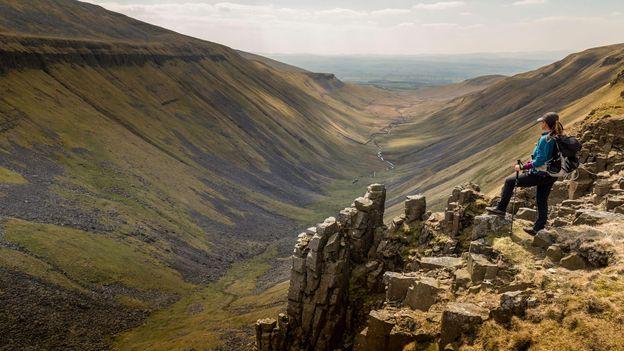Every journey starts with one small step, to paraphrase Chinese philosopher Lao Tzu. But some journeys contain more steps than others.
“The most remarkable treks take us to other worlds – places unfamiliar to us,” said author and global trekker Colin Salter, who discovered the pleasures of hiking as a young man, escaping from the confines of boarding school to explore Scottish mountains with friends. “They’re a way to discover new climates, new terrain, new altitudes and new cultures. They’re physical challenges with sensory rewards – wildlife, botany, scenic grandeur, new music, old stories and shared experiences with fellow travellers on life’s footpath.”
Salter has compiled more than 50 of the world’s best hiking routes in his new book Remarkable Treks: Plan the Walking Trip of a Lifetime on the World’s Most Spectacular Trails. From the Inca Trail (Peru) to the John Muir Trail (US), the West Highland Way (Scotland) to the Milford Track (New Zealand), famous hiking routes inspire travellers to test their mettle and experience some of the most astounding natural landscapes on the planet, while lesser-known trails offer a chance to discover hidden corners of countries and cultures. Here, Salter chooses five of his favourites.
Iceland’s 55km Laugavegur Trail takes in a landscape shaped by fire and ice (Credit: Alamy/Remarkable Treks)
1) The Laugavegur Trail, Iceland
Length: 55km Duration: 3-4 days Start: Landmannalaugur Finish: Thórsmörk
The Laugavegur Trail is a tough-but-rewarding introduction to the Land of Ice and Fire’s wild interior. The starting point, Landmannalaugur (180km from Reykjavik), has hot rivers to bathe in. But the trek isn’t always so relaxing, taking in a wilderness of black desert, mirror-like lakes, rushing waterfalls, craggy canyons and the mountain ridges of Thórsmörk (Thor’s Wood).
“Iceland’s oldest geology is younger than Britain’s youngest,” said Salter. “To walk through this raw landscape, which is still being created and shaped by fire and ice, is to get some sense of how worlds are made.”
For those not yet sated at Thórsmörk, the Fimmvörðuháls trail leads an additional 26km south to Skógafoss waterfall and the coast.
Mount Roraima is home to plants and animals found nowhere else on Earth (Credit: Alamy/Remarkable Treks)
2) Mount Roraima, Venezuela
Length: 64km Duration: 6 days Start/Finish: Paraitepuy
Iconic Mount Roraima is the highest peak in the Pakaraima chain of eastern Venezuela’s tabletop mountains. According to the Indigenous Pemon and Kapon cultures’ folklore, the 15km-long and 5km-wide massif is the stump of a giant tree that once provided all the fruit and vegetables for the world. Here, water cascades from the towering cliffs into rainforests that contain plants and animals found nowhere else on Earth, including the Roraima bush toad.
“The sheer sides and flat summit of Mount Roraima are unlike anywhere else on the planet,” said Salter. “This triangular ship of rock carries a lost world on its deck.”
The trailhead is around 90km from Santa Elena de Uairén, from where travellers can organise guided expeditions. The ascent can be done in two or three days, but Salter recommends taking six to nine days to explore the high plateau, where hikers will find bathing pools at “the Jacuzzis”, the Crystal Valley that’s filled with quartz, and Maverick’s Rock, Roraima’s highest point (2,810m), plus the concrete marker where three countries – Venezuela, Guyana and Brazil – meet.
The 130km Gokyo Lakes trek takes in majestic Himalayan scenery (Credit: Alamy/Remarkable Treks)
3) Gokyo Lakes and Cho La, Nepal
Length: 130km Duration: 17 days Start/Finish: Lukla
“The Gokyo Lakes trek is a cracker,” said Salter. “It’s a trail to the furthest edges of human habitation, across glaciers, beneath the world’s highest peaks, in a landscape of profound spirituality.”
Climbing Mount Everest might be beyond the legs, lungs and wallets of many travellers, but this trek that takes in Everest Base Camp is an opportunity to hike through majestic Himalayan mountainscapes.
Starting from Lukla (2,860m), a 40-minute flight from Kathmandu, the route hits maximum altitudes of 5,545m. Hikers will find suspension bridges, river valleys, waterfalls, rhododendron forests, remote villages, Buddhist monasteries and colourful prayer flags as they stay in guesthouses along the way. The trail enters Sagarmatha National Park, a World Heritage Site that contains the Gokyo Lakes – 19 pristine lakes regarded as holy by Buddhists and Hindus – and Everest itself. The Cho La pass (5,420m) is renowned as one of the trek’s toughest sections.
The Pembrokeshire Coast Path hugs the rugged Welsh coastline for 186 miles (Credit: Alamy/Remarkable Treks)
4) The Pembrokeshire Coast Path, Wales
Length: 186 miles Duration: 12-15 days Start: Amroth Finish: St Dogmaels
The Pembrokeshire Coast Path (PCP) opened in 1970, with almost the entire length of the trail falling within Pembrokeshire Coast National Park in south-west Wales.
Most walkers start at Amroth, to the south, so the route begins gently and finishes with the more demanding sections in the north, staying at B&Bs, hotels, pubs or campsites along the way.
Highlights of this wild, rugged coast include Saundersfoot harbour, Pembroke Castle, Strumble Head Lighthouse and 13th-Century St Govan’s Chapel, with incredible natural beauty in the likes of Barafundle Beach (one of 58 beaches along the route).
“Roman, Viking and Norman invasions left their mark on this coast, as have ordinary people’s efforts to make a living from the sea,” said Salter. “Pembrokeshire has castles, harbours and beaches galore.”
The PCP ends at the village of St Dogmaels. But if you want to keep walking, the PCP is part of the 870-mile-long Wales Coast Path.
Hiking the Pacific Crest Trail requires careful preparation and planning (Credit: Alamy/Remarkable Treks)
5) The Pacific Crest Trail, US and Canada
Length: 2,653 miles Duration: 5 months Start: Campo, California Finish: Manning Park, British Columbia
A true epic, the Pacific Crest Trail (PCT) is the second-longest trail in the US (after the coast-to-coast American Discovery Trail). It runs between the country’s southern and northern borders, from Mexico to Canada, passing through California, Oregon and Washington along the mountain ridges of the Sierra Nevada and the Cascades, and up across the border into Canada.
“The crest that divides America’s river systems into east and west also ties together the riches of its many landscapes, like jewels on a bootlace,” said Salter.
The terrain is fantastically diverse, from desert to snowy mountains, sandstone outcrops to deep blue lakes, pine forests to volcanoes. The PCT also cuts through six national parks, including Yosemite.
Such a massive undertaking requires careful preparation and planning. The Pacific Crest Trail Association provides a compulsory (free) permit, with hikers required to declare a start date.
—
Join more than three million BBC Travel fans by liking us on Facebook, or follow us on Twitter and Instagram.
If you liked this story, sign up for the weekly bbc.com features newsletter called “The Essential List”. A handpicked selection of stories from BBC Future, Culture, Worklife and Travel, delivered to your inbox every Friday.









